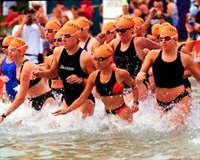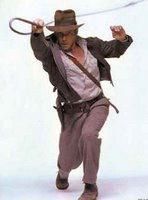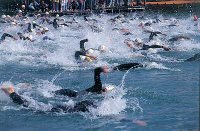Wednesday, August 16, 2006
Un-Kicking - Pt. III
 With the 2-whip picture in mind, I swam again a few days later, and once again I started off with the old style of kicking. A few skating drills later, plus a few Popov lengths/drills and I was back into my new groove. This time around I was paying attention to the fact that my body's neuromuscular memory had some deeply ingrained habits.
With the 2-whip picture in mind, I swam again a few days later, and once again I started off with the old style of kicking. A few skating drills later, plus a few Popov lengths/drills and I was back into my new groove. This time around I was paying attention to the fact that my body's neuromuscular memory had some deeply ingrained habits. Then I remembered a comment that I had read in the TI discussion forum. Runners, someone said, tend to have inflexible ankles, and therefore tend to kick with a pawing action that is woefully ineffective, failing to point their toes.
I took this advice to heart when I heard it recently, and dutifully began stretching exercises before swimming, while trying to point my toes during laps. This approach yielded only a slight improvement.
I now saw (for the first time) that there might be a connection between the volume of cycling and running that triathletes do, and poor kicking form. The cycling and running motions are continuous circular movements that involve a great deal of lower leg muscles to stabilize the foot through the ankle. However, in swimming the feet and lower leg muscles are relatively loose.
Perhaps the reason that the best swimmers all point their toes, is because they are not kicking. After all, "kicking" an object like a football (soccer-ball) uses muscles in the foot and ankle, and requires them to be held firmly. As an old footballer (soccer player) I spent all my youth kicking balls.
The best swimmers are not kicking. Instead, it is more accurate to say that they are whipping.
I tested this out in the water. First, I tried running in the water with a pedalling/cycling motion. Then I tried swimming with the same motion, and discovered that the motion was eerily similar to my old "kicking motion." It was terribly ineffective, and I had that feeling beginning swimmers with a cycling/running background report of "moving backwards."
Now, I knew where I was coming from. To test where I wanted to get to, I told myself to swim with a whip kick. I had a miscue.
I found myself doing a full dolphin kick, with both legs kicking together. I stopped, and then gave myself the image of cracking two whips, one after the other.
It worked wonders, and I cracked a big smile.
Practicing Cracking the Whips (vs. kicking )
I went a bit further and started to think about what kinds of drills I could use, and also how to focus my mind on two whips cracking.
1. Focus Points
When a whip cracks, the entire whip is loose, apart from the handle.
(See a video of a kid playing with a bull whip here.)
a) In the body, the handle of the whip would run up the side, and the legs would make up the entire length. The muscles of the leg are loose, until given a command to whip from the hip and side of the body. This is NOT kicking, but whipping.
b) The foot is held loosely, waiting for an undulation or signal to reach it. When it comes, it responds the way the end of a whip responds.
c) If the whipping image is a hard one to hold, what helped me early on was to focus on using the upper leg above the knee as the handle. In other words, I would try to whip the lower leg by moving the upper leg. In retrospect, I believe this to be an intermediate point of focus, for temporary use only.
2. Drills
a) The Popov 2-leg kick drill mentioned before involves doing dolphin-kicks with both arms outstretched and touching. The body assumes a comfortable 60-90 degree angle. Breaths are taken as needed. While I don't look like Popov, here is my inspired version:
At times, I alternate from the Popov 2-leg drill into "Fish" -- freestyle kicking, while trying to retain that same whipping motion in each leg. While this sounds complicated, it is actually not so hard to do in practice once the feeling is captured in the body, or the sensation is ingrained. Here is what I am talking about:
b) The one-leg kick drill is the same as the 2-leg version, except that the leg not in use is bent to prevent it from being used.
In this way I am trying to make a seamless transition from the dolphin whip kick, to a 2-whip kick, one leg at a time.
The focus during these drills is on developing the whipping action. I intersperse them with swim laps to help me further ingrain the feeling.
New Ideas
I have noticed that it is much easier to "drive the high hip down" and to "use the kick to initiate the roll."
There may be different ways to name these sensations so that they fit in better with the notion of ''whipping." We shall see!
Double-Whips - Pt. II
 I now more clearly understood Terry Laughlin's genius. Over a series of several books on swimming he has been able to translate some of the body sensations that come from perfect form into new language. He coined phrases such as "pressing your buoy" and "swimming downhill" to try to convey the sensation he was feeling when swimming perfectly into words.
I now more clearly understood Terry Laughlin's genius. Over a series of several books on swimming he has been able to translate some of the body sensations that come from perfect form into new language. He coined phrases such as "pressing your buoy" and "swimming downhill" to try to convey the sensation he was feeling when swimming perfectly into words.Once the feelings were translated into words, he could then design drills to reinforce the new feeling. He did this by helping the swimmer practice over and over until the body could produce the new sensation automatically, and without thinking.
Coming up with the new language and practices is, I now know, not the nice linear process I just described. Instead, it takes significant trial and error to get it to the point where someone else could use it.
This I learned from experience.
At first, I just wanted to retain the feeling and the measurable results.
I immediately went to the internet to check the Total Immersion (TI) archives. I found some discussion and articles related to kicking, but they all seemed to be describing the same end-result - a kick that started from the hip, rather than in the legs -- rather than a step-by-step process that is the feature of Terry's step-by-step approach. . For example, this post on connecting leg drive and hip drive.
I have read about that for years in the TI books. Now, I had actually experienced it. But so what? I still had no guarantee that I would ever feel the same sensation again.
Earlier in the year, I had the fortune of discovering an Alexander Popov clip on YouTube. As a word-record holder in the 100m sprint, his technique is amazing to watch. I figured that if I watched him swim I might learn a thing or two.
As I clicked on his video for perhaps the 20th time I could see where he was indeed kicking from the hip. Frankly, it looked a bit superhuman, and once again I had the feeling that he was born with a gift that the rest of us could only observe on YouTube.
Then all of a sudden I saw something.
Fortunately, they had also recorded Popov's drills, and there he was doing something I had never tried. It looked like a butterfly drill.
Popov was on his side, underwater, with both his arms outstretched. He was dolphin-kicking his way down the pool.
And, he was looking like I felt in the pool!
OK, that sounded weird.
His body had the same undulating feeling I felt when I was doing the skating drill, or at least I thought it did. His looked like some exotic mermaid. I had a feeling that I looked more like a wounded walrus...
But the same "body-waves" were causing his arms to move horizontally also! Here in the Popov video clip, taken from a 13 minutes clip that has been one YouTube for a while.
I could barely wait to get back to the pool.
2 days later, I pushed off from the wall. And not a damn thing happened.
Gone were the waves and whipping and undulation. I was swimming the way I always had, with a kick that was as disjointed as ever.
But I had a feeling that this would happen, and was not surprised, although, to be honest I had been hoping for a miracle... secretly.
I quickly switched back over to my drills, and sure enough, it all came back. The skating drill has turned out to be the best way for me to isolate and focus on the sensation. I ran through a set of drills - skating, under-skate, under-switch, over-switch - trying to keep the feeling going.
The I tried the Popov drill, with the underwater dolphin kick.
And it worked. He must be a smart fellow.
I could only manage 5 yards to his 20, and I looked more like a wounded mermaid than walrus this time around. But I could now feel the whip start someplace up above my hips. My outstretched arms and feet seemed to be going along for the ride.
Essentially, I was dolphin-kicking down the pool on my side, and as I experimented I found that if I allowed my body to relax into a 60 degree angle or so, it felt even better.
Perhaps the fact that I cannot swim butterfly helps...
The effect on my freestyle, however, was instant. All I had to do was first envision, and then feel each of my legs whipping independently.
It was almost as if I had a whip in each hand, cracking one after the other (like the guy in the picture above.)
The 9 Disciplines of Triathlon
 I am often asked what it takes to be a triathlete, and given that I am a rather mediocre one, I tend to have to work harder on the few gains that I make over time. When I complete an Ironman, people asked me how I could ever bring it off.
I am often asked what it takes to be a triathlete, and given that I am a rather mediocre one, I tend to have to work harder on the few gains that I make over time. When I complete an Ironman, people asked me how I could ever bring it off.I would often reply that it has more to do with scheduling and discipline than anything else involving swimming, cycling and running, which is what most people do not realize.
I thought about it some more, and came up with the following list of must-haves, beyond a mere ability to do the three sports.
The 10 Essential Disciplines of Triathlon
- drilling
- eating and drinking
- resting
- sequencing and planning workouts
- clothing/equipping/packing
- injury recovering
- racing
- calendaring and time budgeting
- researching
- money budgeting
1. Drilling: the skill and patience required to repeat the same activity over and over in a discipline that focuses on one single action, with the hope of building new skill in the overall activity. For example, when a pianist does scales over and over, it is not because he or she will ever do them in competition or performance. Likewise in triathlon, and especialy in swimming, drilling is critical to improving performance.
2. Eating and Drinking, or nutrition, includes what the athlete consumed during racing, before racing and after racing. Everyday meals also need to be tracked carefully.
3. Resting is said by some to be even moe important than long work outs, because this is the time when the body does the important ob of rebuilding after exertion.
4. Sequencing and Planning Workouts involves using a training philosophy and a set of race-preparation principles to build a schedule of activity that covers several weeks, involving training as well rest, and hard weeks with weeks of reduced activity.
5. Clothing, equipping and packing involves picking the right equipment to wear and use, and learning to pack the right amount for races, and how to ship it from place to place. There are numerous choices to be made, and all must work together and be maintained.
6. Injury recovery is a capacity that every triathlete must have in order to respond effectively to inevitable overuse problems and accidents. Learning how to stop training activity is important in helping the body to heal itself.
7. Calendaring and time budgeting is probably the single skill that separates the triathlete from the wannabees. While many people can muster the physical talen to complete even the smallest of races, most are stopped by an inability to schedule themselves to complete the required training. I use the Getting Things Done approach to arrange my calendar of activities, including training dates. For the vast number of triathletes who are non-professionals, this means fitting in workouts into busy lives tha include many other items of competing interest.
8. Researching means finding good sources of information, and using them to do every aspect of the sport, including these surprising disciplines. There is a growing body of knowledge regarding the sport, most of which is online and some of which is in print. The ability to find this information is important.
9. Money budgeting - most triathletes are busy people who live with finite budgets and cannot afford top of the line equipment. They must make choices as to what to invest and when, and someone who cannot make a budget and stick to it will not last long in the sport!
Mastery of these 9 disiplines are second only to a basic ability to do the three sports, and the skills that enable an athlete with potential to move from merely having talent to realizing results. For the average athlete, these skills mean the difference between enjoying the sport, and worrying about it or dropping out altogether because on of them is missing.
Starting with a Breakthrough - Pt. I
 I asked myself - What was the source of this breakthrough in swimming strength? Or, more importantly, how can I sustain it?
I asked myself - What was the source of this breakthrough in swimming strength? Or, more importantly, how can I sustain it?It began on a routine skating drill, which involves kicking without using the arms,while gliding along on one side. The lower arm is extended,while the other is relaxed alongside the body.
All of a sudden, I noticed (after 7 + years of doing this drill) that my legs were moving differently. Instead of kicking, it felt like they were whipping.
The lower arm/hand was moving back and forth horizontally (by less than six inches) as the legs whipped alternately. Actually, it felt as if the entire right and left sides of my body were whipping, and the arm/hand was merely going along for the ride. The effect on my shoulders was that they felt like they were rolling back and forth in keeping with the rhythm in my legs.
It felt good - I could feet water moving past me a bit quicker, even though I was not working as hard.
This intrigued me, so I tested it with some regular swimming. I was astounded.
Whereas I had been taking 10-11 strokes per length, I was now taking 8-9 (in a very short pool.)
For a swimmer, this just does not happen.
I repeated it to make sure I was not fooling myself, but I was clearly in a new zone. I could feel it, and now I could measure it.
My next job was much, much harder -- How do I repeat it?
Tuesday, August 15, 2006
Mastery
 One of the reasons I am so interested in triathloning is that it offers a way to have fun while attempting to master three sports that I am not all that good at.
One of the reasons I am so interested in triathloning is that it offers a way to have fun while attempting to master three sports that I am not all that good at.While I love sports, (and no, chess is not a sport), I don't have outrageous talent in any discipline I have tried. Of the three sports that make up triathlon, cycling is probably my strongest and swimming my weakest, relative to the average triathlete.
But, the lack of natural taltent makes me work my brain and spirit that much harder, and allows me to really focus on mastering the disciplines slowly, and deliberately, with great great planning and foresight, rather than by gift. I consider myself a diligent, thoughtful type --- so mastery for me has to do with using these strengths to get better.
In previous blogs I wrote about :
Jumping from the Plateau
Swimming, Mastery and Customer Service
Mastery and the Plateau
Cycling in Kingston at 4:00am
These have helped bring me to the start of this blog.
Training for a Race
 Today while I was swimming in the pool I decided to start a new blog focusing on the countdown to my race on Nov 12th, the Miamiman Triathlon.
Today while I was swimming in the pool I decided to start a new blog focusing on the countdown to my race on Nov 12th, the Miamiman Triathlon. While I have two other blogs, I just could not see myself mixing the contents of "Moving Back to Jamaica" and "Chronicles from a Caribbean Cubicle" given that they serve such different purposes. As far as I could see, this one would serve an entirely different audience, and would be first blog that I have that has nothing to do with my nationality.
What spurred me on were a few blogs that I wrote on swimming and on mastery.
I recently had a breakthrough in my swimmingm using the Total Immersion approach, and this came after years of practicing that technique, even as it has evolved. I somehow wanted to capture what I had learned about myself, with this new breakthrough in words, but I have never been a fan of keeping a private journal.
Afte all, we are all going to die, so what is the big secret about anyway?
So, I figured that rather than keep a private training log, I would keep a public one. And, instead of writing stuff like "ran 4 miles, felt tired" I would be able to get into the things that really interest me about the sport, and maybe even might interest others.
After all, it is an area of my life that I am committing to mastering so... here I go!
